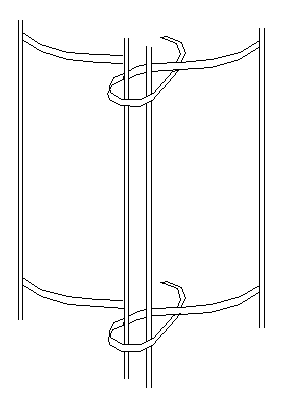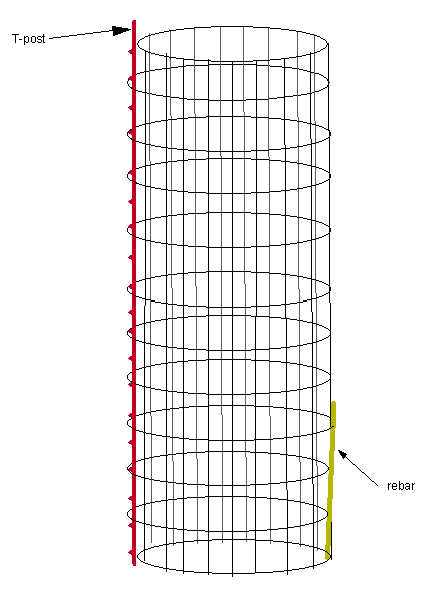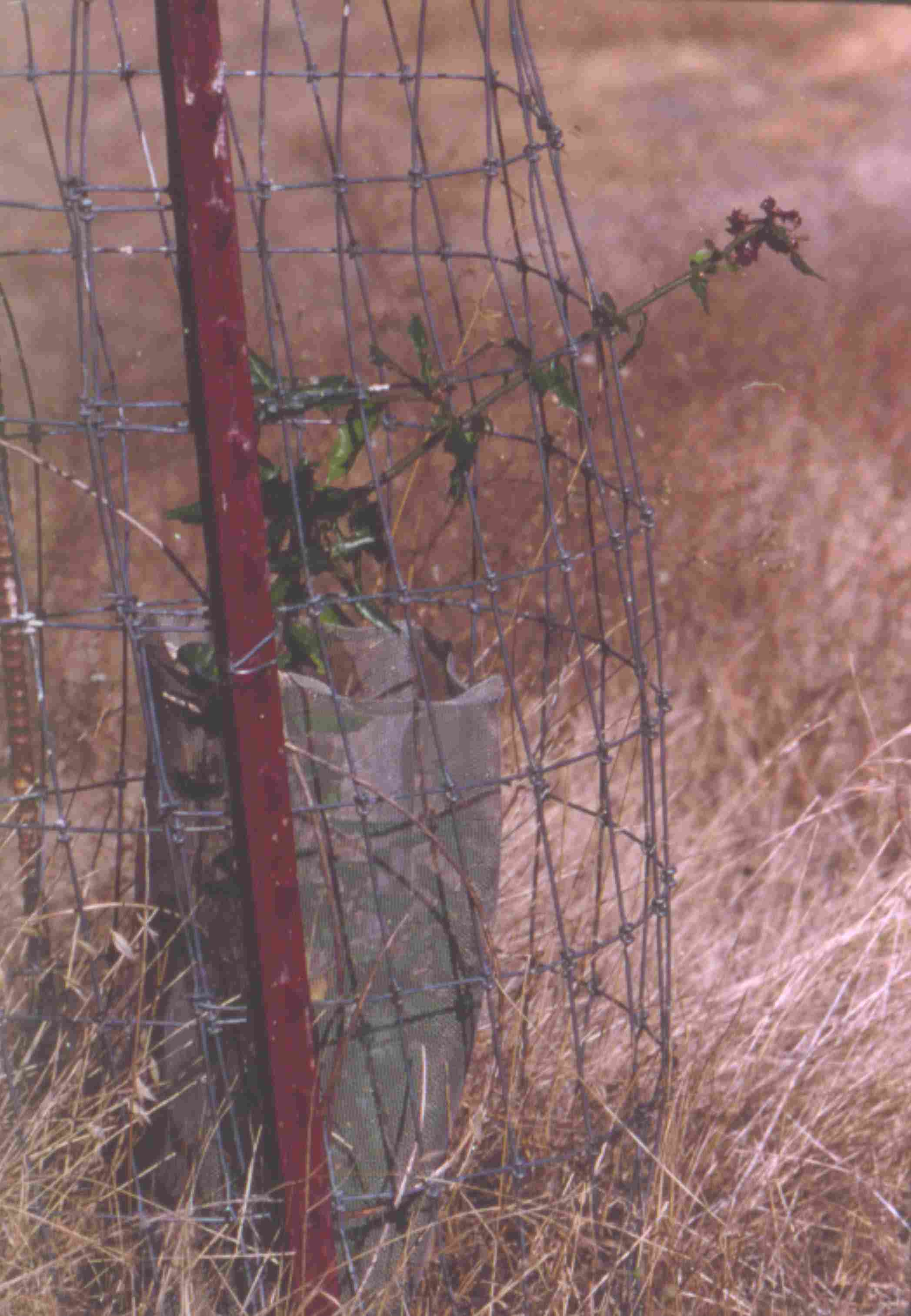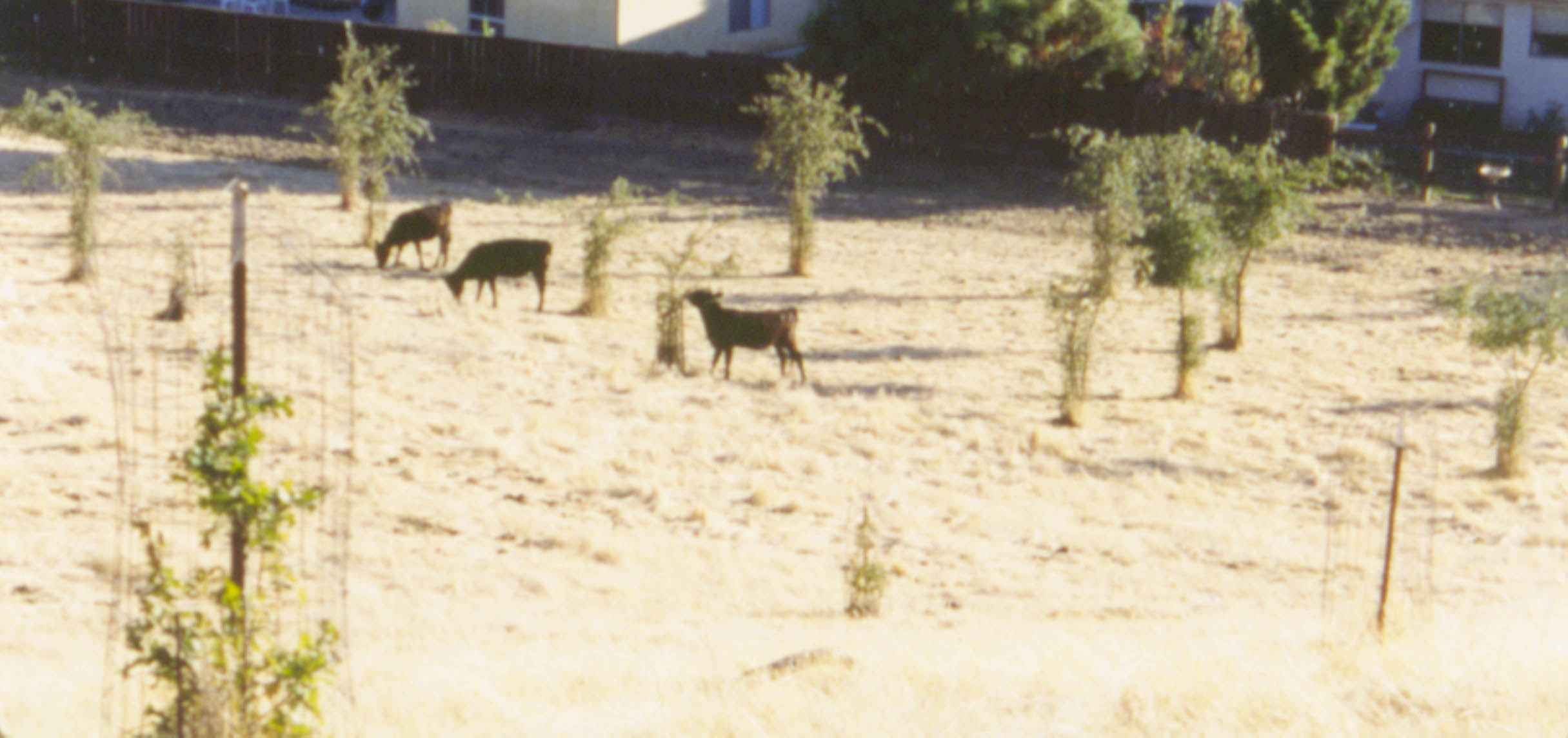Protection of individual planting sites
Design, construction, and field performance of cattle-resistant Vaca cages
Damage caused by animals can severely limit the growth and survival of oak seedlings and saplings. Livestock, deer, and rodents all have the potential to limit or eliminate oak reproduction, but the relative importance of each herbivore varies by location. Livestock, most commonly cattle, are especially damaging to oaks and are the single most important herbivore limiting oak regeneration in much of California’s oak woodlands. Browsing and trampling by cattle can kill individual seedlings and depletes the understory seedling bank. Cattle browsing can also indefinitely suppress the growth of seedlings that would otherwise recruit to sapling and tree size classes. Cattle browsing prolongs the period that juvenile oaks remain in small size classes. Because small oaks are most susceptible to both herbivory and fire, oak seedlings and saplings that are suppressed by livestock browsing have a much lower chance of success than oaks that are protected from excessive browsing. The impact of livestock herbivory varies somewhat by species. The less palatable live oaks Q. agrifolia and Q. wislizeni are less severely browsed than valley oak (Q. lobata) and blue oak (Q. douglasii).
The simplest way to establish oaks in an area used by livestock is to simply exclude livestock from the area at least until oaks have grown tall enough to ensure that the saplings cannot be seriously damaged by livestock. In practice, this can be a fairly long period of time, from 10 to 20 years or more, depending on site quality and the oak species involved. In cases where it is not possible to exclude livestock from an entire site, it is still possible to establish oaks by planting within small exclosures, such as Vaca cages. We have also installed Vaca cages over existing natural seedlings or saplings that were being suppressed by cattle browsing. These established oaks can often respond with rapid height growth once they are protected.
Figure 1. Cattle-resistant Vaca cages are essential to allow oaks to grow above browse line on grazed sites.
Vaca cage design considerations
Any number of possible structures can be made to protect oak seedlings from
cattle. Our objective was to develop the least expensive exclosure possible
that had the following characteristics:
- provide adequate protection against cattle browsing;
- made of materials that are readily available and easy to transport;
- relatively simple to construct, install and maintain.
Vaca cage materials
Fence fabric:
12 gauge (minimum) galvanized 2 by 4 inch mesh wire
fence fabric, 4 or 5 feet wide.
-Note that lighter gauge wire will not survive cattle damage.
Large mesh sizes (e.g. 4 x 4 inch field fence) will allow cattle to reach in
and yank off branches.
-The fence fabric may be either welded or made with joints held by a twisted
wire. Compared with welded wire, the twisted wire fabric is a bit more expensive,
somewhat less rigid, and generally longer-lasting. We have used both types of
wire and now prefer the twisted wire fabric because the welds of the welded
fabric will eventually break if cattle abuse the cages very much.
- A 56 inch length of fabric is required for each cage; 21 cages can be made
from a 100 foot roll, leaving 5 inches of excess.
- Cages made with 4 foot wide fabric are not quite tall enough to protect trees
as they begin to emerge out the top, and an extension 1-2 ft tall will need
to be added. Wider (5 ft) fabric is more expensive, and the final foot of protection
may not be needed for 10 to 20 years after planting. The decision on which fabric
to use is based on economics and the expected growth rate. If growth will likely
be rapid (e.g., valley oak on a high quality site), it may make sense to use
the more expensive, 5 ft wide fabric.
Cage supports:
5-foot steel T-post (medium or heavy weight)
5/8 inch diameter steel reinforcing bar (rebar), 48
inches long
-Note that five lengths can be cut from a standard 20 foot
section of rebar without waste.
Tie-down wire (optional):
14 gauge (minimum) steel wire (galvanized is preferable)
In sites where cages may be subject to removal by
vandals or where cattle use is relatively intense, the fabric can be secured
to the T-post with a short (about 6 inches) piece of twisted wire.
Vaca cage construction
In order to provide maximum protection, Vaca cages must be constructed and installed properly. Use of substandard materials or poor construction technique will increase the likelhood of damage to the cage and the planting site.
The following tools are required for cage construction and installation: heavy duty wire cutters, pliers, post driver, small (one hand) sledge hammer. Gloves are recommended.
The fence fabric should be cut within about 1/4 inch of the joints, leaving nearly a 2 inch-long wire end projecting from one edge of the cut fabric. The fabric is formed into a cylinder approximately 18 inches in diameter. It is preferable to overlap the ends of the fabric by 2 inches (i.e., one grid cell) when forming the cylinder. The projecting wires are used to wire the cylinder together. The wires should be twisted completely around both vertical wires in the direction shown in Figure 2. Bending the wire in the reverse direction will strain or break the weld nearest to the bent wire. (The direction of the bend is not critical if you use twisted wire fabric). Be sure to use all of the wires to wire the cylinder seam.
The relatively small diameter of the cage and heavy wire gauge provide a fair degree of resistance against forces applied to the sides of the cage. You can figure an average of slightly more than 5 worker-minutes to build each cylinder.

Figure 2. Detail showing direction for bending wire when assembling Vaca cage.
A T-post is driven about 1-1.5 foot into the ground about 9 inches from the center of the planting site. The serrated side (the side with the bumps) of the post should point away from the planting site. After the site is planted, the wire cylinder is woven over the T-post as shown in Figure 3. Note that the T-post is inside of the wire cylinder except at the top and bottom. It is easiest to rotate the wire cylinder about 90 degrees from its final orientation while sliding the cylinder over the post (otherwise it binds on the bumps). When the cylinder is all the way down, it is rotated over the planting site.

Figure 3. Diagram of Vaca cage, showing preferred method for weaving T-post and rebar through cage.
The rebar stake is used to secure the cage on the side opposite the T-post. The tip of the rebar is placed inside of the bottom cage wire and driven 18 - 24 inches into the ground at a slight angle away from the cage. One of the ridged sides of the rebar (not the smooth lengthwise seam) should point outward and the top of the rebar should be about 1 to 2 inches above the nearest horizontal cage wire. The cage is lifted slightly to slip the horizontal wire over the top of the rebar, and then pushed down over the rebar. The serrations on the T-post and the rebar provide resistance to keep the cage from being lifted upwards. If desired, a short length of wire can be looped through the cage fabric and twisted around the T-post. This makes cages more difficult to vandalize and reduces the likelihood that cattle will dislodge the cage by rubbing on it.
A simple modification can be used to provide greater resistance to lateral compression of the cage. At three equally-spaced locations around the top, the upper 6 to 8 inches of the cage is pushed inward to an approximate angle of 45 to 60 degrees. The wire will need to be pulled back into a cylinder shape when the oak reaches the top of the cage. An experienced worker can install a premade cage in about 5 minutes or less (depending on the effort required to drive the post).
The standard Vaca cage configuration shown above uses one T-post and one rebar
stake per cage. This is typically adequate for light to moderate cattle pressure.
If cages are located in areas where cattle congregate or linger for extended
periods (e.g., near water sources, salt licks), the cages will need to be supported
more strongly. One of the following configurations may be used:
A. One T-post, 2 rebar stakes: space the rebar stakes out 1/3 of the cage circumference away from the T-post. This is only slightly more expensive and a bit more work than using a single rebar.
B. Two T-posts: replace the rebar with a second T-post. Both T-posts must be driven before the cage is slipped on. A two-post cage is substantially more sturdy, but is more expensive and considerably more difficult to install. Cages may still be compressed laterally; if this is a problem, rebar can be placed on the sides between the T-posts; this is generally necessary only in areas that get very heavy cattle use.
Vaca cage maintenance
Based on many seasons of field use in several different locations, we have found Vaca cages to be practical and effective cattle exclosure. However, Vaca cages are cattle resistant, not completely immune from cattle damage. Vaca cages are sometimes dislodged by cattle to the point that seedlings are exposed to browsing. Furthermore, in high use areas, such as near water sources, cages are sometimes severely damaged.
Cages should be inspected at least annually (or more often if grazing is intense or year-round) and repaired as necessary to maintain effectiveness. Cages that are subject to more abuse by cattle can be upgraded with additional rebar or a second T-post as noted above. If cattle grazing is only seasonal, some tree branches will grow out through the cage when livestock are not present. Where possible, these should be pulled back into the cage. Also, depending on grazing intensity and oak growth rates, shoots emerging from the 4 foot high cage tops may not escape browsing. In these cases an additional 1-2 foot tall wire fabric cylinder should be wire on top of the Vaca cage. Because cattle don't exert much force on the top of the cage, the extension can be made of 14 gauge wire. When we replace cages that have been battered by cattle, we can usually recycle the old cages by and cutting them in half to make two extensions.
As oaks get larger, branches may be damaged by rubbing against the wire fabric. Generally, the fabric can be cut and bent back to eliminate the problem. Once the trees are clearly large enough to withstand cattle damage, the cages should be removed to avoid scarring of the trunk by the wire.
Protection from deer
Although browsing damage by deer is generally less severe than that caused by cattle, high populations of deer can substantially reduce height growth of oaks by browsing. Cages to prevent deer browsing can normally be constructed of lightweight, less expensive materials than are used to make Vaca cages. We have successfully use cages made of 1 inch diameter wire mesh (poultry netting). Deer cages can be supported by a 5 foot length of rebar or a T-post on one side and a 2 foot length of rebar on the opposite side. Cages should be at least 18 inches in diameter and at least 4 foot tall.
Protection from rodents
Gophers, ground squirrels, and voles can kill juvenile oaks by chewing and girdling stems. Elimination of predators and alterations in vegetative composition and structure can allow rodent populations to increase to high levels, leading to high levels of damage in oak plantings. Rodent populations vary across the landscape and can fluctuate from year to year due to habitat conditions, predators, and pathogens. At restoration sites in Vacaville, CA, vole populations skyrocketed in 1999, leading to significant damage to oak seedlings for the first time in 10 years of restoration efforts. Damage was most severe on seedlings with thin, smooth outer bark, although some larger trees with thick bark were also affected. One young valley oak tree nearly 4 inches in DBH was girdled at its base.
In some situations, acceptable levels of protection from rodents can be achieved simply by avoiding sites with high rodent activity. We have demonstrated that valley oak seedling survival was significantly lower among sites located within 10 to 15 m of an active ground squirrel colony than among sites located farther away from the colony (Bernhardt and Swiecki 2000). Protective devices can also be installed at planting to provide protecton against rodents. Because these devices add additional cost and effort to planting project, you should determine whether they are needed at your site before planting.
Small cylinders of wire mesh or aluminum screening can be used to protect planted acorns or seedlings from voles, gophers, ground squirrels and other rodents. Poultry netting, hardware cloth, or aluminum window screen is formed into a small cylinder, typically 6 to 8 inches in diameter. Larger mesh sizes (up to about 1 .5 inch) can be used against gophers and ground squirrels but relatively fine mesh (about 0.5 inch or less) is needed to exclude voles. Cages used to exclude ground squirrels and voles should extend at least 1 ft above the soil surface and need to have at least 4 inches of the lower edge buried below ground to anchor the cage. For gophers, closed-end cages can be buried below ground to a depth of at least 1 ft and should extend at least 1 ft above ground. Girdling of oak roots is a possibility as roots systems increase in size if the below-ground wire does not corrode in a timely manner. Cages should be closed on top initially, but need to inspected during the growing season amd opened as shoots reach the top. Once cages are opened, seedlings will be vulnerable to rodent activity, but older established seedlings have a better chance of resprouting if they are girdled than do younger seedlings which have fewer reserves.
Short (1-2 ft) plastic treeshelters can also be used to protect seedlings from voles and ground squirrels. We have also tested using modified treeshelters to protect against gopher damage. We have used 2 ft tall plastic tree shelters which have 1 inch diameter holes bored in the bottom half. The treeshelters were installed so that the bottom half (1 ft) was buried below ground. The purpose of the holes is to allow soil moisture levels to equilibrate between the inside and outside of the below-ground portion of the treeshelter. We do not yet have enough information to know how well this protective device will work over the long-term.
Shading
Both window screen cages and treeshelters have an additional property - they provide a significant amount of shade to the seedling. Whether this is beneficial or detrimental depends to some degree on the oak species and the site. In general, most oak seedlings growing in dry sites (e.g., south facing slopes) can benefit from summer shade during their first year or two of life. Shade seems to be particularly critical for blue oak and live oak seedlings growing in hot, dry sites. In cooler, moist sites, especially on north-facing slopes, additional shade provided by window screen cylinders or treeshelters may be excessive and may reduce early seedling growth.

Figure 4. This 4-year-old live oak seedling grown from a direct-seeded acorn has outgrown the screen cage installed when it was planted. The screen cage is nested within a Vaca cage (made with twisted wire fabric).
